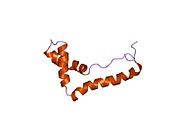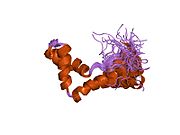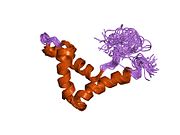HMGB1
Ensembl |
| ||||||||
|---|---|---|---|---|---|---|---|---|---|
| UniProt |
| ||||||||
| RefSeq (mRNA) |
| ||||||||
| RefSeq (protein) |
|
| |||||||
| Location (UCSC) | Chr 13: 30.46 – 30.62 Mb | n/a | |||||||
| PubMed search | [2] | n/a | |||||||
| View/Edit Human | |||
High mobility group box 1 protein, also known as high-mobility group protein 1 (HMG-1) and amphoterin, is a protein that in humans is encoded by the HMGB1 gene.[3][4]
HMG-1 belongs to the
Function
Like the histones, HMGB1 is among the most important chromatin proteins. In the nucleus HMGB1 interacts with nucleosomes, transcription factors, and histones.[5] This nuclear protein organizes the DNA and regulates transcription.[6] After binding, HMGB1 bends[7] DNA, which facilitates the binding of other proteins. HMGB1 supports transcription of many genes in interactions with many transcription factors. It also interacts with nucleosomes to loosen packed DNA and remodel the chromatin. Contact with core histones changes the structure of nucleosomes.
The presence of HMGB1 in the nucleus depends on posttranslational modifications. When the protein is not acetylated, it stays in the nucleus, but hyperacetylation on lysine residues causes it to translocate into the cytosol.[6]
HMGB1 has been shown to play an important role in helping the RAG endonuclease form a paired complex during V(D)J recombination.[8]
Role in inflammation
HMGB1 is secreted by immune cells (like
ADP-ribosylation of HMGB1 by PARP1 inhibits removal of apoptotic cells, thereby sustaining inflammation.[12] TLR4 binding by HMGB1 or LPS (lipopolysaccharide) sustains ADP-ribosylation of HMGB1 by PARP1 thereby serving as an amplification loop for inflammation.[12]
HMGB1 has been proposed as a DNA vaccine adjuvant.[13] HMGB1 released from tumour cells was demonstrated to mediate anti-tumour immune responses by activating Toll-like receptor 2 (TLR2) signaling on bone marrow-derived GBM-infiltrating DCs.[14]
Interactions
HMGB1 has to
HMGB1 is a nuclear protein that binds to DNA and acts as an architectural chromatin-binding factor. It can also be released from cells, in which extracellular form it can bind the inflammatory receptor
HMGB1 can interact with TLR ligands and cytokines, and activates cells through the multiple surface receptors including
Interaction via TLR4
Some actions of HMGB1 are mediated through the
Clinical significance
HMGB1 has been proposed as a target for cancer therapy,
The
Recently, a study provided evidence of an association between raised levels of HMGB1 and attention to detail and systemizing in unmedicated children with high-functioning Autism spectrum disorder (ASD), suggesting that inflammatory processes mediated by HMGB1 may play a role in the disruption of neurobiological mechanisms regulating cognitive processes in ASD.[26] In this study, HMGB1 serum concentrations in children with ASD were found significantly higher than those of typically developing children. Additionally, HMGB1 serum concentrations were positively correlated with the Autistic quotient (AQ) attention to detail score and the Systemizing Quotient (SQ) total score in the ASD group.[27] However, comprehensive evidence in children is limited, highlighting the need for in-depth research towards understanding possible mechanisms linking HMGB1 with the core features of ASD. Nevertheless, it has been suggested that HMGB1 could be a reliable inflammatory marker, explaining the link between inflammatory processes and several autistic traits, and therefore a possible therapeutic target in this neurodevelopmental disorder.
References
- ^ a b c GRCh38: Ensembl release 89: ENSG00000189403 – Ensembl, May 2017
- ^ "Human PubMed Reference:". National Center for Biotechnology Information, U.S. National Library of Medicine.
- PMID 8661151.
- PMID 11279268.
- PMID 16102963.
- ^ PMID 18431461.
- PMID 28303166.
- PMID 23293004.
- PMID 10398600.
- PMID 20547845.
- PMID 19948257.
- ^ PMID 31877876.
- PMID 21544096.
- PMID 19143470.
- PMID 11106654.
- PMID 11748221.
- PMID 20192808.
- PMID 23954397.
- S2CID 21350171.
- PMID 19414536.
- PMID 22076468.
- PMID 14763124.
- PMID 32380958.
- PMID 35027067.
- ^ PMID 25510912.
- PMID 34198762.
- PMID 34198762.
Further reading
- Thomas JO, Travers AA (March 2001). "HMG1 and 2, and related 'architectural' DNA-binding proteins". Trends in Biochemical Sciences. 26 (3): 167–74. PMID 11246022.
- Andersson U, Erlandsson-Harris H, Yang H, Tracey KJ (December 2002). "HMGB1 as a DNA-binding cytokine". Journal of Leukocyte Biology. 72 (6): 1084–91. S2CID 11409274.
- Wu H, Wu T, Hua W, Dong X, Gao Y, Zhao X, Chen W, Cao W, Yang Q, Qi J, Zhou J, Wang J (March 2015). "PGE2 receptor agonist misoprostol protects brain against intracerebral hemorrhage in mice". Neurobiology of Aging. 36 (3): 1439–50. PMID 25623334.
- Erlandsson Harris H, Andersson U (June 2004). "Mini-review: The nuclear protein HMGB1 as a proinflammatory mediator". European Journal of Immunology. 34 (6): 1503–12. S2CID 11470463.
- Jiang W, Pisetsky DS (January 2007). "Mechanisms of Disease: the role of high-mobility group protein 1 in the pathogenesis of inflammatory arthritis". Nature Clinical Practice. Rheumatology. 3 (1): 52–8. S2CID 428632.
- Ellerman JE, Brown CK, de Vera M, Zeh HJ, Billiar T, Rubartelli A, Lotze MT (May 2007). "Masquerader: high mobility group box-1 and cancer". Clinical Cancer Research. 13 (10): 2836–48. S2CID 32922516.
- Fossati S, Chiarugi A (2007). "Relevance of high-mobility group protein box 1 to neurodegeneration". International Review of Neurobiology. 82: 137–48. PMID 17678959.
- Parkkinen J, Rauvala H (September 1991). "Interactions of plasminogen and tissue plasminogen activator (t-PA) with amphoterin. Enhancement of t-PA-catalyzed plasminogen activation by amphoterin". The Journal of Biological Chemistry. 266 (25): 16730–5. PMID 1909331.
- Wen L, Huang JK, Johnson BH, Reeck GR (February 1989). "A human placental cDNA clone that encodes nonhistone chromosomal protein HMG-1". Nucleic Acids Research. 17 (3): 1197–214. PMID 2922262.
- Bernués J, Espel E, Querol E (May 1986). "Identification of the core-histone-binding domains of HMG1 and HMG2". Biochimica et Biophysica Acta (BBA) - Gene Structure and Expression. 866 (4): 242–51. PMID 3697355.
- Ge H, Roeder RG (June 1994). "The high mobility group protein HMG1 can reversibly inhibit class II gene transcription by interaction with the TATA-binding protein". The Journal of Biological Chemistry. 269 (25): 17136–40. PMID 8006019.
- Parkkinen J, Raulo E, Merenmies J, Nolo R, Kajander EO, Baumann M, Rauvala H (September 1993). "Amphoterin, the 30-kDa protein in a family of HMG1-type polypeptides. Enhanced expression in transformed cells, leading edge localization, and interactions with plasminogen activation". The Journal of Biological Chemistry. 268 (26): 19726–38. PMID 8366113.
- Zappavigna V, Falciola L, Helmer-Citterich M, Mavilio F, Bianchi ME (September 1996). "HMG1 interacts with HOX proteins and enhances their DNA binding and transcriptional activation". The EMBO Journal. 15 (18): 4981–91. PMID 8890171.
- Xiang YY, Wang DY, Tanaka M, Suzuki M, Kiyokawa E, Igarashi H, Naito Y, Shen Q, Sugimura H (February 1997). "Expression of high-mobility group-1 mRNA in human gastrointestinal adenocarcinoma and corresponding non-cancerous mucosa". International Journal of Cancer. 74 (1): 1–6. PMID 9036861.
- Rasmussen RK, Ji H, Eddes JS, Moritz RL, Reid GE, Simpson RJ, Dorow DS (1997). "Two-dimensional electrophoretic analysis of human breast carcinoma proteins: mapping of proteins that bind to the SH3 domain of mixed lineage kinase MLK2". Electrophoresis. 18 (3–4): 588–98. S2CID 37336552.
- Jayaraman L, Moorthy NC, Murthy KG, Manley JL, Bustin M, Prives C (February 1998). "High mobility group protein-1 (HMG-1) is a unique activator of p53". Genes & Development. 12 (4): 462–72. PMID 9472015.
- Milev P, Chiba A, Häring M, Rauvala H, Schachner M, Ranscht B, Margolis RK, Margolis RU (March 1998). "High affinity binding and overlapping localization of neurocan and phosphacan/protein-tyrosine phosphatase-zeta/beta with tenascin-R, amphoterin, and the heparin-binding growth-associated molecule". The Journal of Biological Chemistry. 273 (12): 6998–7005. PMID 9507007.
- Nagaki S, Yamamoto M, Yumoto Y, Shirakawa H, Yoshida M, Teraoka H (May 1998). "Non-histone chromosomal proteins HMG1 and 2 enhance ligation reaction of DNA double-strand breaks". Biochemical and Biophysical Research Communications. 246 (1): 137–41. PMID 9600082.
- Claudio JO, Liew CC, Dempsey AA, Cukerman E, Stewart AK, Na E, Atkins HL, Iscove NN, Hawley RG (May 1998). "Identification of sequence-tagged transcripts differentially expressed within the human hematopoietic hierarchy". Genomics. 50 (1): 44–52. PMID 9628821.
- Boonyaratanakornkit V, Melvin V, Prendergast P, Altmann M, Ronfani L, Bianchi ME, Taraseviciene L, Nordeen SK, Allegretto EA, Edwards DP (August 1998). "High-mobility group chromatin proteins 1 and 2 functionally interact with steroid hormone receptors to enhance their DNA binding in vitro and transcriptional activity in mammalian cells". Molecular and Cellular Biology. 18 (8): 4471–87. PMID 9671457.
- Wu H, Wu T, Han X, Wan J, Jiang C, Chen W, Lu H, Yang Q, Wang J (January 2017). "Cerebroprotection by the neuronal PGE2 receptor EP2 after intracerebral hemorrhage in middle-aged mice". Journal of Cerebral Blood Flow and Metabolism. 37 (1): 39–51. PMID 26746866.
- Jiao Y, Wang HC, Fan SJ (December 2007). "Growth suppression and radiosensitivity increase by HMGB1 in breast cancer". Acta Pharmacologica Sinica. 28 (12): 1957–67. PMID 18031610.
- Andersson U, Ottestad W, Tracey KJ (May 2020). "Extracellular HMGB1: a therapeutic target in severe pulmonary inflammation including COVID-19?". Mol Med. 26 (1): 42(2020). PMID 32380958.
External links
- HMGB1+protein,+human at the U.S. National Library of Medicine Medical Subject Headings (MeSH)
- Pancreatic Cancer Research and HMGB1 Signaling Pathway
- PDBe-KB provides an overview of all the structure information available in the PDB for Human High mobility group protein B1 (HMGB1)
- PDBe-KB provides an overview of all the structure information available in the PDB for Rat High mobility group protein B1 (HMGB1)









